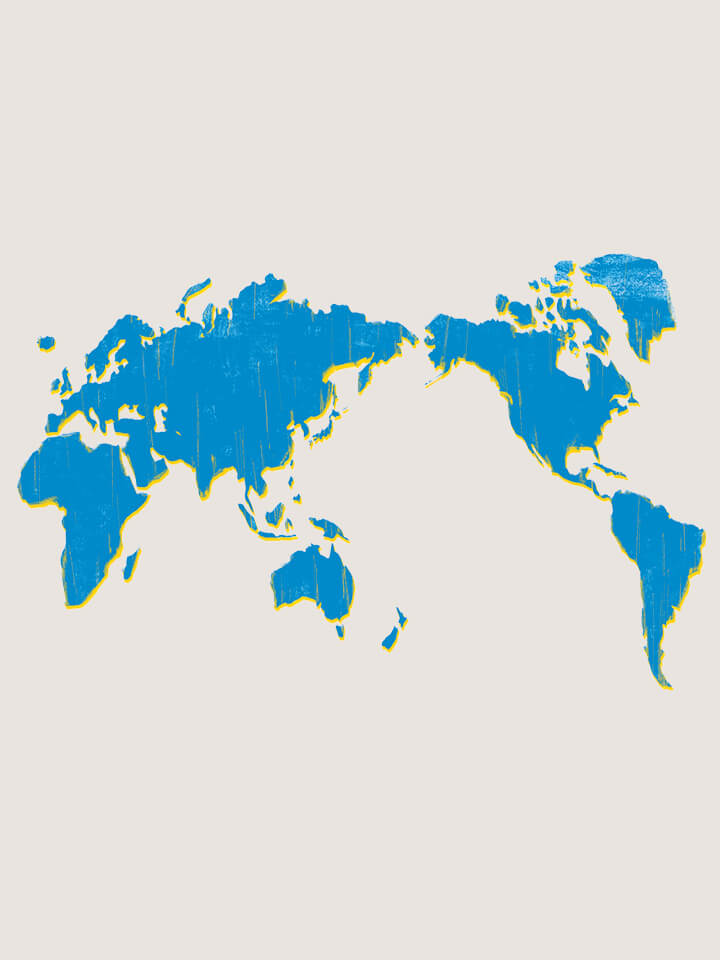
Knowledge: World Leather
World Leather:A trip around the world's leather producing regions

The raw material for leather is the skin of living animals. "Leather" can be made from creatures with "skin" such as mammals, reptiles, amphibians, and fish. Most of them have developed along with the local culture and its people. In each region, the technique for processing beautiful leather from creatures developed based on what was suitable for the particular climate.
Who was the first to use leather in the world? It is said to be an archaic Neanderthal, and not only have pointed tools for hunting been found, but also stone tools that efficiently remove meat from the skin have been excavated from their ruins. From here, a "tanning" technique develops, such as removing the meat, pouding the skin, rubbing, and smoking it. Leather processing is believed to have evolved from cold regions such as Russia, Canada, Norway and Sweden, where primitive tanning equipment have been found.
First, it developed as winter clothing, then for items used in rituals, daily necessities, and since modern times as an ornament. Leather, which is closely related to the environment and the people living there, has been subject to various restrictions in recent years due to the growing awareness of animal protection and environmental protection. Techniques that can be used have been restricted, but as a result, further technological advances have been made.
Leather home 01
South America, where there are still many places where people cannot set foot, is home to a wide variety of creatures. Crocodiles and snakes are known in tropical areas such as the Amazon, and lizards are known in relatively cold areas such as Chile. Animals such as goats and their subspecies are also bred as livestock, and the culture of removing fur and leather from them is still alive and upheld.
Leather home 02
The warm and stable climate of Oceania is known around the world for its high-quality materials such as saltwater crocodile, sharkskin and ostrich. Not only large and medium-sized leather, but also small-sized leather such as snakes and lizards are also abundant. It is also famous for many types of marsupials such as kangaroos, which have been used for military purposes in modern times.
Leather home 03
Crocodiles are bred on a large scale in tropical Southeast Asia. They are bred for their skin, but are also treated as food, and are closely related to the culture and history of the region. Many species inhabit the region, such as the saltwater crocodile, which is known for being ferocious but having beautiful scales, and the Siamese crocodile, which has a unique olive color.
Leather home 04
Leather is a "secondary industrial product" after it has been used for food. In the United States, where people consume a large amount of beef, tanning technology has inevitably developed in line with the consumption. Not only that, it is also a production center of "raw hides", which is a raw material for leather, and is exported to many countries including Japan. The Native American leather culture is also noteworthy, with beautiful crafts still remaining.
Leather home 05
Cuba is home to many beautiful crocodiles. Overhunting had occurred over the crocodile leather before the Washington Treaty for Animal Protection was signed. Therefore, sadly, the "Cuban crocodile" bearing the name of the country is on the verge of extinction, but besides the crocodile, it is also famous for snakes such as anaconda and pythons.
Leather home 06
Indonesia is home to a wide variety of reptiles such as crocodiles, snakes and lizards. Many Indonesian products include beautiful pythons called "diamond pythons" and the finest products that are prized as "ringmark lizards". Many of these reptiles are bred, allowing for higher quality exotic leather that can be shipped in a cleaner condition than those found in the wild.
Leather home 07
Germany is known for its advanced chemical industry. Many chemicals are used to process leather. Germany is a country where the research is very advanced. Having a food culture that consumes beef and pork, the technology of tanning and dyeing leather, which is a by-product of the food culture, has developed. There are also global clothing brands, and they are also attracting attention for their accessories.
Leather home 08
Africa is home to a myriad of exotic leathers such as crocodiles, snakes, lizards, ostriches and elephants. It has a completely different charm from other areas. The Nile monitor lizard, the Nile crocodile, and the African rock python, which is also known for its length of 7 to 8 m, are also famous for their large size and high utility value. Some products cannot be imported into Japan depending on the place of origin.
Leather home 09
Italian leather known for its soft and exquisite coloring. A gem created by the history of vegetable based tanning from ancient times and the simultaneous development of dyeing technology. During the Renaissance, decorative techniques (embossing, stamping, coloring, etc.) boasting perfect beauty were established, and leather was actively used not only for books and swords, but also for interiors.
Leather home 10
France is home to some of the world's most famous brands of leather goods. Naturally, many of the finest leathers come to this country. The country has undergone many battles since the Middle Ages, and has a history of inheriting and applying reliable techniques for manufacturing harnesses, carriage tools, and weapons. In addition, there are many famous tanners that meet the needs of the country where elegant leather is preferred.
Leather home 11
Leather has been used for saddles and other harnesses, as well as for books that pass on knowledge. Depending on the application, it may be robust or supple. In any case, England is also known to produce durable and long-lasting leather, and even today, leather is produced by traditional techniques. Many tanners are known for their closely guarded techniques. In addition, there are many world-famous brands in the field of men's shoes.